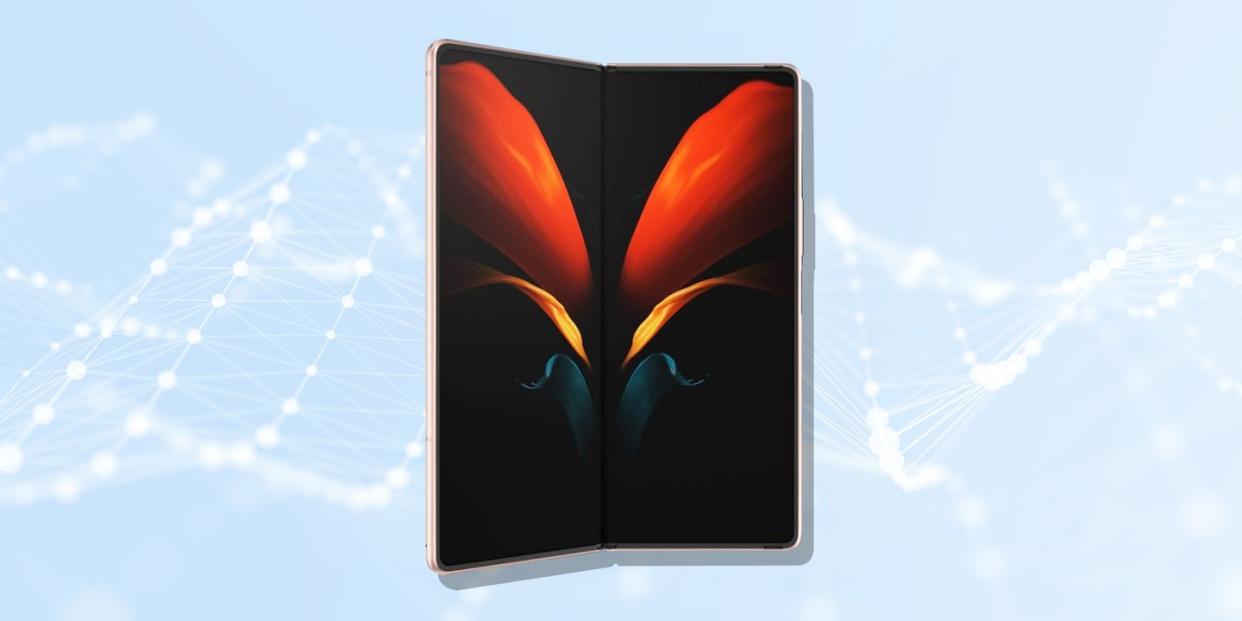Samsung's Folding Phone Went From Laughable Gimmick to Serious Contender in One Year

Nothing, pandemic or otherwise, can stop the smartphone wars from barreling ahead. iPhone versus Galaxy versus Pixel—new models release every year around the holidays in an endless, exhausting, capitalist battle for dominance. And because of the blind loyalty of the smartphone armies (Apple's army goes with Apple, Galaxy's army goes with Galaxy, Pixel's army goes with Pixel), all that money spent on flashy ads promoting massive cameras seems useless. But as the world becomes more tech savvy, it is starting to push these companies to do more than just add cameras and expand storage. This year, for example, we're getting 5G. And then there's Samsung's second iteration of its Galaxy Fold. You were right to laugh the first Fold off. But this one's different.
The first Galaxy Fold was a smartphone that opened and closed like a book, with a small screen on the outside and easily the largest screen in the smartphone market on the inside. The tech was undoubtedly cool, and great for watching movies, playing games, or just generally having more space to multitask, like a second monitor for your computer. Game changer. But the original Fold, the one that was supposed to get the smartphone armies hopped up on folding screens, didn't meet its pure potential with enough development time, and thus felt like one awesome idea stuck in an outdated, unbecoming gadget.
Now comes the Galaxy Z Fold 2, a shining example of why we need to be patient. The Z Fold 2 feels, looks, and operates like a tool from the future. The bevels are thinner, the edges are cleaner, the screens are brighter, and the literal fold in the middle has almost entirely disappeared. The front screen is bigger with few hardware interruptions, and holy shit, what a difference that makes. As for the inner screen, I’ve blasted through a ton of Mario Kart Tour on this guy, and it takes the mobile game from snack to full meal.
This phone isn't fit for everyone—the price and size will do that—but the Galaxy Z Fold 2 is definitely one of the more unique smartphones on the market. The actual folding tech it uses, with its utter and endless potential, gives my nerd self stomach butterflies. Imagine a tablet that could be folded into the user's preferred screen width, or a laptop that could shrink to an eighth of its full size, or a smartphone that could operate like a papyrus scroll. I know I sound like a manic sci-fi fan, which, let's be clear, I totally am, but the Z Fold 2 shows us that it's possible.
While the foldable screen may seem like a gimmick—much like Wii's motion controls or VR once did—look at the larger picture. It’s step one. Motion controls were used solely for Wii Sports; now they are used in thousands of games. VR used to be extremely expensive and basic, and now you can buy a fully functional VR headset for $299. Beyond that, VR is being used for medical and mental health purposes, helping individuals address PTSD by easing memory interaction, or helping those with physical trauma relearn the motions required with physical therapy. Sometimes gimmick is the stepping stone to an entirely new field, and the Z Fold 2 not only has that potential, but it showed it in just one year of improvement.
To get from the cool-but-ridiculous first Galaxy Fold to the functionally impressive Z Fold 2, Samsung says it researched how consumers would actually use the phone. "Technological advancements need to focus on providing useful value from the consumers’ perspective," Samsung's principal designer Jun-yong Song said in an email, "and not for the sake of parading new technology." And while a lot of tech companies give the “we listen to you” pitch, the upgrades made addressed the exact issues I had with the first phone. If Samsung is invested in improving its technology from gimmick, that's the first step to better development. Again, patience is needed.
The problem with the current smartphone market is the rush to release a new phone every year. We’re getting into 5G models with the big three—Google revealed the Pixel 4a 5G last week, Apple's rumored announcement comes next week, and Samsung's been selling the Galaxy Note 20 5G for two months—but that's largely it on the feature front, besides slightly higher res, maybe some new authentication methods, and of course, an abundance of added camera features. They're the same basic upgrades we've seen every year. (I realize I may look like a fool if Apple comes out and changes it up next week, but as of right now, that seems unlikely.) At least the Fold feels like it's some kind of innovation in the dry smart phone ring.
A few other phones have jumped on the folding trend, most notably the Motorola Razr, an old-school flip phone with an elongated folding screen. Folding screen tech is not going away anytime soon. Do I think we’ll see a massive shift because of the Samsung Galaxy Z Fold 2 in the next year or two? I don't, but given time (and R&D), we could see another form factor shift, similar to what the iPhone did for cell phones. While you can't be blamed for feeling exhausted, apathetic, or downright over the smartphone wars, I'll continue to pay attention—and to misuse this tech to clap noobs as DK in Mario Kart Tour with a damn twinkle in my eye.
You Might Also Like

